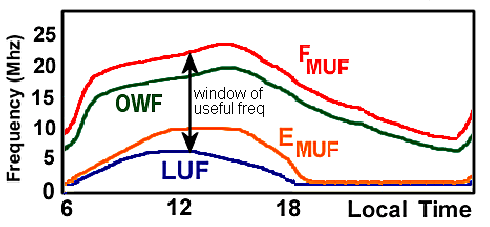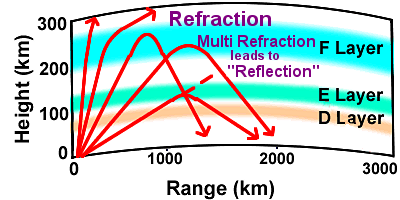
 Understanding the LUF and MUF
Understanding the LUF and MUF
Why are ham bands closed on occasions?
Introduction
When ham bands are described as "closed," it indicates that the conditions for effective communication on those specific frequency bands are poor or non-existent. This can happen for several reasons, primarily related to ionospheric conditions.
MUF and LUF in Skywave Communications
MUF and LUF are key concepts in skywave communications. These indicators define the frequency window that can support a reliable skywave communication circuit. Knowing the current MUF and LUF allows you to choose the optimal frequency for a communication circuit. Go too high, and your signal will be lost in space. Go too low, and it will be absorbed before it can travel anywhere. These limits are constantly changing due to changes in daylight hours, solar activity, and atmospheric conditions, making them a moving target for anyone relying on HF propagation.
Definitions
MUF is the highest frequency returned to Earth at a given distance and is affected by factors such as sunspot activity, time of day, year, latitude, and antenna transmission angle, but not by transmitter power or receiver sensitivity.
During the day, the ionospheric E and F regions "reflect" skywaves below the MUF:
Factors affecting MUF:- Increased solar irradiation raises the MUF, peaking at noon and in summer.
LUF is the lowest usable frequency in the HF band where the received field intensity is sufficient to provide the necessary signal-to-noise ratio. During daylight, the ionospheric D-region absorbs skywaves below approximately 10 MHz. The amount of energy absorbed by the lower ionosphere (particularly the D region) has a direct impact on the LUF.
Factors affecting the LUF:- The D-region absorbs frequencies below the LUF, preventing signals from reaching the E and F regions.
- Between sunrise and noon, increased solar irradiation increases D-region absorption, resulting in a higher LUF.
- Frequencies below 10 MHz experience greater absorption compared to higher bands.
- Solar flares elevate the LUF, narrowing the usable HF skywave window.
Window of Usable Frequency Range
The range between LUF and MUF defines the usable HF skywave window.

Figure 3: Typical diurnal cycle based on Naval Postgraduate School training materials
| FMUF: F region maximum usable frequency OWF: The optimum working frequency is usually 85% of the MUF. EMUF: E region maximum usable frequency LUF: The lowest usable frequency due to D-region absorption. |
Why are Ham Bands Closed on Occasions?
Ham bands may be closed or less usable for various reasons, including increased solar activity and unique ionospheric conditions. In particular, intense solar flares can elevate the LUF above the MUF until the LUF-MUF window collapses, as shown in Figure 4.
During a strong Sudden Ionospheric Disturbances (SID), the LUF will increase to a frequency higher than the MUF, thus closing the usable frequency window, an event called a fadeout or blackout.


